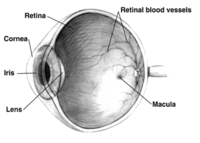
The Mouse Retinal Organoid Trisection Recipe: Efficient Generation of 3D Retinal Tissue from Mouse Embryonic Stem Cells.
Sign Up to like & getrecommendations! Published in 2019 at "Methods in molecular biology"
DOI: 10.1007/978-1-4939-8669-9_9
Abstract: The introduction of stem cell-based technologies for the derivation of three-dimensional retinal tissues, the so-called retinal organoids, offers many new possibilities for vision research: Organoids facilitate studies on retinal development and in vitro retinal disease… read more here.
Keywords: retinal organoid; embryonic stem; mouse embryonic; retinal organoids ... See more keywords

Role of mTORC1 activity during early retinal development and lamination in human-induced pluripotent stem cell‐derived retinal organoids
Sign Up to like & getrecommendations! Published in 2022 at "Cell Death Discovery"
DOI: 10.1038/s41420-022-00837-5
Abstract: Retinal organoids derived from human-induced pluripotent stem cells (hiPSC) are powerful tools for studying retinal development as they model spatial and temporal differentiation of retinal cell types. Vertebrate retinal development involves a delicate and coordinated… read more here.
Keywords: development; retinal organoids; retinal development; role ... See more keywords

Retinal Organoids derived from hiPSCs of an AIPL1-LCA Patient Maintain Cytoarchitecture despite Reduced levels of Mutant AIPL1
Sign Up to like & getrecommendations! Published in 2020 at "Scientific Reports"
DOI: 10.1038/s41598-020-62047-2
Abstract: Aryl hydrocarbon receptor-interacting protein-like 1 (AIPL1) is a photoreceptor-specific chaperone that stabilizes the effector enzyme of phototransduction, cGMP phosphodiesterase 6 (PDE6). Mutations in the AIPL1 gene cause a severe inherited retinal dystrophy, Leber congenital amaurosis… read more here.
Keywords: reduced levels; cytoarchitecture despite; mutant aipl1; retinal organoids ... See more keywords

Human Retinal Organoids Provide a Suitable Tool for Toxicological Investigations: A Comprehensive Validation Using Drugs and Compounds Affecting the Retina
Sign Up to like & getrecommendations! Published in 2022 at "Stem Cells Translational Medicine"
DOI: 10.1093/stcltm/szab010
Abstract: Abstract Retinal drug toxicity screening is essential for the development of safe treatment strategies for a large number of diseases. To this end, retinal organoids derived from human pluripotent stem cells (hPSCs) provide a suitable… read more here.
Keywords: cell; provide suitable; cell types; retina ... See more keywords

Absence of Connexin 43 results in smaller retinas and arrested, depolarized retinal progenitor cells in human retinal organoids.
Sign Up to like & getrecommendations! Published in 2022 at "Stem cells"
DOI: 10.1093/stmcls/sxac017
Abstract: The development of the vertebrate retina relies on complex regulatory mechanisms to achieve its characteristic layered morphology containing multiple neuronal cell types. While connexin 43 (CX43) is not expressed by mature retinal neurons mutations in… read more here.
Keywords: absence connexin; gja1; retinal organoids; retinal progenitor ... See more keywords

Toward Retinal Organoids in High-Throughput.
Sign Up to like & getrecommendations! Published in 2023 at "Cold Spring Harbor perspectives in medicine"
DOI: 10.1101/cshperspect.a041275
Abstract: Human retinal organoids recapitulate the cellular diversity, arrangement, gene expression, and functional aspects of the human retina. Protocols to generate human retinal organoids from pluripotent stem cells are typically labor intensive, include many manual handling… read more here.
Keywords: organoids high; high throughput; retinal organoids; human retinal ... See more keywords

Incorporating microglia‐like cells in human induced pluripotent stem cell‐derived retinal organoids
Sign Up to like & getrecommendations! Published in 2023 at "Journal of Cellular and Molecular Medicine"
DOI: 10.1111/jcmm.17670
Abstract: Microglia are the primary resident immune cells in the retina. They regulate neuronal survival and synaptic pruning making them essential for normal development. Following injury, they mediate adaptive responses and under pathological conditions they can… read more here.
Keywords: pluripotent stem; microglia like; retinal organoids; induced pluripotent ... See more keywords

Generation of Retinal Organoids with Mature Rods and Cones from Urine-Derived Human Induced Pluripotent Stem Cells
Sign Up to like & getrecommendations! Published in 2018 at "Stem Cells International"
DOI: 10.1155/2018/4968658
Abstract: Urine cells, a body trash, have been successfully reprogrammed into human induced pluripotent stem cells (U-hiPSCs) which hold a huge promise in regenerative medicine. However, it is unknown whether or to what extent U-hiPSCs can… read more here.
Keywords: medicine; human induced; pluripotent stem; induced pluripotent ... See more keywords

Characterization of Primary Cilia Formation in Human ESC-Derived Retinal Organoids
Sign Up to like & getrecommendations! Published in 2023 at "Stem Cells International"
DOI: 10.1155/2023/6494486
Abstract: Objectives Primary cilia are conserved organelles found in polarized mammalian cells that regulate neuronal growth, migration, and differentiation. Proper cilia formation is essential during eye development. Our previous reports found that both amacrine and retinal… read more here.
Keywords: day; cilia formation; derived retinal; retinal organoids ... See more keywords

In situ autofluorescence lifetime assay of a photoreceptor stimulus response in mouse retina and human retinal organoids.
Sign Up to like & getrecommendations! Published in 2022 at "Biomedical optics express"
DOI: 10.1364/boe.455783
Abstract: Photoreceptors are the key functional cell types responsible for the initiation of vision in the retina. Phototransduction involves isomerization and conversion of vitamin A compounds, known as retinoids, and their recycling through the visual cycle.… read more here.
Keywords: autofluorescence lifetime; visual cycle; situ autofluorescence; retinal organoids ... See more keywords

Human iPSC-derived RPE and retinal organoids reveal impaired alternative splicing of genes involved in pre-mRNA splicing in PRPF31 autosomal dominant retinitis pigmentosa
Sign Up to like & getrecommendations! Published in 2018 at "Journal of Clinical Investigation"
DOI: 10.2139/ssrn.3155753
Abstract: Mutations in pre-mRNA processing factors (PRPFs) cause 40% of autosomal dominant retinitis pigmentosa (RP), but it is unclear why mutations in ubiquitously expressed PRPFs cause retinal disease. To understand the molecular basis of this phenotype,… read more here.
Keywords: retinitis pigmentosa; autosomal dominant; impaired alternative; dominant retinitis ... See more keywords